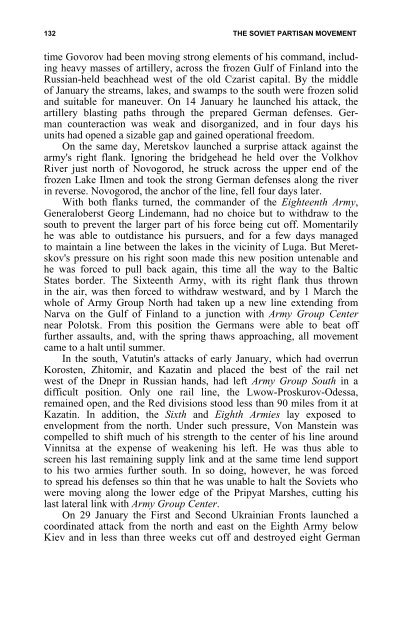the soviet partisan movement 1941-1944 by edgar m. howell
the soviet partisan movement 1941-1944 by edgar m. howell
the soviet partisan movement 1941-1944 by edgar m. howell
Create successful ePaper yourself
Turn your PDF publications into a flip-book with our unique Google optimized e-Paper software.
132 THE SOVIET PARTISAN MOVEMENT<br />
time Govorov had been moving strong elements of his command, including<br />
heavy masses of artillery, across <strong>the</strong> frozen Gulf of Finland into <strong>the</strong><br />
Russian-held beachhead west of <strong>the</strong> old Czarist capital. By <strong>the</strong> middle<br />
of January <strong>the</strong> streams, lakes, and swamps to <strong>the</strong> south were frozen solid<br />
and suitable for maneuver. On 14 January he launched his attack, <strong>the</strong><br />
artillery blasting paths through <strong>the</strong> prepared German defenses. German<br />
counteraction was weak and disorganized, and in four days his<br />
units had opened a sizable gap and gained operational freedom.<br />
On <strong>the</strong> same day, Meretskov launched a surprise attack against <strong>the</strong><br />
army's right flank. Ignoring <strong>the</strong> bridgehead he held over <strong>the</strong> Volkhov<br />
River just north of Novogorod, he struck across <strong>the</strong> upper end of <strong>the</strong><br />
frozen Lake Ilmen and took <strong>the</strong> strong German defenses along <strong>the</strong> river<br />
in reverse. Novogorod, <strong>the</strong> anchor of <strong>the</strong> line, fell four days later.<br />
With both flanks turned, <strong>the</strong> commander of <strong>the</strong> Eighteenth Army,<br />
Generaloberst Georg Lindemann, had no choice but to withdraw to <strong>the</strong><br />
south to prevent <strong>the</strong> larger part of his force being cut off. Momentarily<br />
he was able to outdistance his pursuers, and for a few days managed<br />
to maintain a line between <strong>the</strong> lakes in <strong>the</strong> vicinity of Luga. But Meretskov's<br />
pressure on his right soon made this new position untenable and<br />
he was forced to pull back again, this time all <strong>the</strong> way to <strong>the</strong> Baltic<br />
States border. The Sixteenth Army, with its right flank thus thrown<br />
in <strong>the</strong> air, was <strong>the</strong>n forced to withdraw westward, and <strong>by</strong> 1 March <strong>the</strong><br />
whole of Army Group North had taken up a new line extending from<br />
Narva on <strong>the</strong> Gulf of Finland to a junction with Army Group Center<br />
near Polotsk. From this position <strong>the</strong> Germans were able to beat off<br />
fur<strong>the</strong>r assaults, and, with <strong>the</strong> spring thaws approaching, all <strong>movement</strong><br />
came to a halt until summer.<br />
In <strong>the</strong> south, Vatutin's attacks of early January, which had overrun<br />
Korosten, Zhitomir, and Kazatin and placed <strong>the</strong> best of <strong>the</strong> rail net<br />
west of <strong>the</strong> Dnepr in Russian hands, had left Army Group South in a<br />
difficult position. Only one rail line, <strong>the</strong> Lwow-Proskurov-Odessa,<br />
remained open, and <strong>the</strong> Red divisions stood less than 90 miles from it at<br />
Kazatin. In addition, <strong>the</strong> Sixth and Eighth Armies lay exposed to<br />
envelopment from <strong>the</strong> north. Under such pressure, Von Manstein was<br />
compelled to shift much of his strength to <strong>the</strong> center of his line around<br />
Vinnitsa at <strong>the</strong> expense of weakening his left. He was thus able to<br />
screen his last remaining supply link and at <strong>the</strong> same time lend support<br />
to his two armies fur<strong>the</strong>r south. In so doing, however, he was forced<br />
to spread his defenses so thin that he was unable to halt <strong>the</strong> Soviets who<br />
were moving along <strong>the</strong> lower edge of <strong>the</strong> Pripyat Marshes, cutting his<br />
last lateral link with Army Group Center.<br />
On 29 January <strong>the</strong> First and Second Ukrainian Fronts launched a<br />
coordinated attack from <strong>the</strong> north and east on <strong>the</strong> Eighth Army below<br />
Kiev and in less than three weeks cut off and destroyed eight German
















